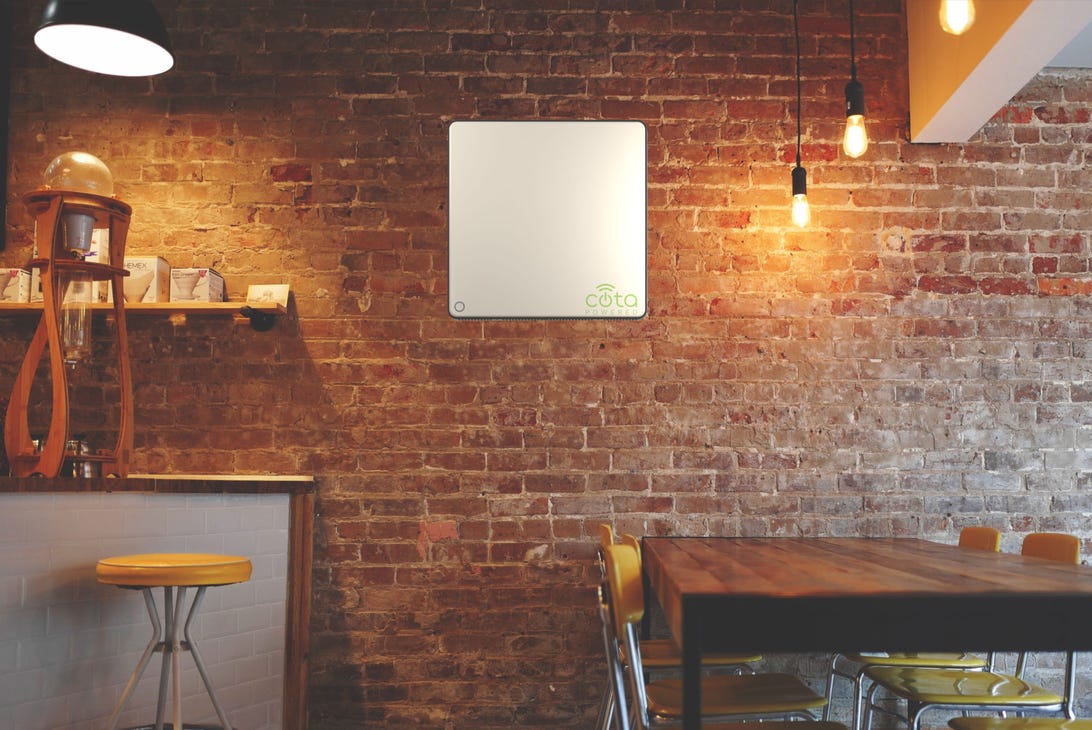
Startup Ossia hopes homes, conferences rooms and coffee shops will install its flat charging stations to beam power wireless to devices like security cameras, smartwatches or security cameras.
Ossia
If you’re enthusiastic about your mobile gadgets, you may have a wireless charging pad in your house on which you can plop your phone for a battery top-up. A host of companies, though, hope for a more liberating technology that beams power through the air, and one of them, Ossia, just cleared a regulatory hurdle clearing its way into products in the UK and Europe.
The approval is an important step in making longer-distance wireless charging a product reality, but it’s only one step. Companies like Ossia, Energous and GuRu have been backing the charging technology for years without much adoption beyond a few niches and demonstrations.
Ossia’s approval follows an OK by the Federal Communications Commission in the US, but that’s only for charging distances up to 1 meter — about 3 feet. The European and UK approvals are unlimited in range, though the practical limit for the company’s technology is about 10 meters, said Chief Executive Doug Stovall, and the company expects US approvals for longer-range use.
The companies all hope that charging cables and charging pads will look as dated as Ethernet network cables in the days of Wi-Fi. Long-range wireless power could free us from charging anxiety with phones, hearing aids, security cameras, heart rate monitors, smart doorbells and other devices. Ultimately, ubiquitous charging could mean smaller batteries or even none at all.
“Charging goes from an active effort, where a device has to be captive, to something in the background,” as automatic as your phone retrieving your email instead of bygone days when you had to tell your computer to check in, said Ali Hajimiri, CEO of Ossia competitor GuRu. That company is working with Motorola to commercialize the longer-range charging.
Long-range wireless charging challenges
Several hurdles stand in the way of greater success. One is the classic technology chicken and egg issue: Without widespread charging stations to beam power, there’s little incentive for device makers to support the technology, and without device maker support, there’s no reason for consumers to buy a hub. An Ossia station is a flat square about a foot on each side.

GuRu’s long range wireless charging station can be built into a desk lap. Beaming power to a room’s worth of devices would take a station about four times as large, a square about 8 inches on edge.
GuRu
Another challenge is that each charging system is proprietary, which means a GuRu-charged phone won’t work with an Ossia-powered charging station. The standards issue bogged down charging pads for years. Only when Apple sided with the Qi standard in the iPhone 8 did the wireless charging pad chaos settle down.
And even short-range wireless charging hasn’t been a smash hit, said Creative Strategies analyst Carolina Milanesi. “Many people are still finding it hard to justify wireless charging in the more traditional way due to the longer time it takes to charge. With distance you are adding more complications without an apparent real reward,” she said.
Certifications should help, Ossia’s Stovall said. “The regulations have now caught up to what our partners are offering. When we first started selling, there was no regulatory approval. Our partners were moving ahead because we believed the market would catch up,” he said.
More certifications coming
The company is working on certification in China in partnership with manufacturing powerhouse Foxconn and in Japan with Toyota Group. “We expect full regulatory approval there shortly,” he said.
Among other companies working on wireless charging:

